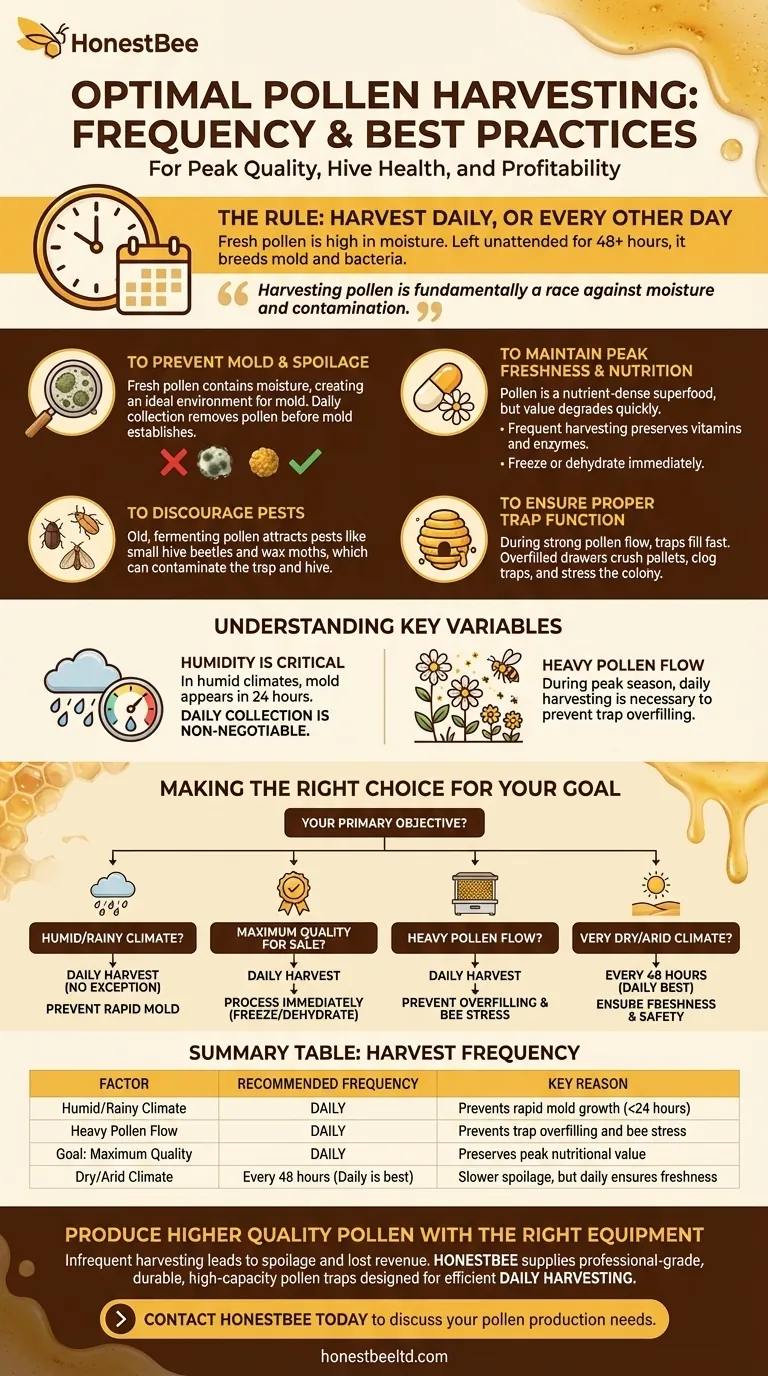For optimal quality and hive health, pollen should be harvested from your traps daily, or at the very least, every other day. This frequent collection schedule is essential because fresh pollen is high in moisture, making it a prime breeding ground for mold and bacteria if left unattended for more than 48 hours.
Harvesting pollen is fundamentally a race against moisture and contamination. While the collection itself is simple, your frequency determines the final product's quality, safety, and nutritional value. Daily collection is the professional standard for a reason.

The Critical Reasons for Frequent Collection
Understanding why daily harvesting is the standard practice will help you produce a superior product and maintain a healthier hive. The risks associated with infrequent collection are significant and easily avoided.
To Prevent Mold and Spoilage
Freshly collected pollen pellets are soft and contain moisture. When left in the collection drawer, this moisture creates the perfect environment for mold to grow, rendering the entire batch unusable and potentially hazardous.
Collecting daily or every other day removes the pollen before mold has a chance to establish itself.
To Maintain Peak Freshness and Nutrition
Pollen is a nutrient-dense superfood. However, its nutritional value, including vitamins and enzymes, begins to degrade quickly after it leaves the bee.
Frequent harvesting ensures you are preserving the pollen in its most potent state. After collection, it should be cleaned and immediately frozen or dehydrated to lock in that freshness.
To Discourage Pests
A drawer full of old, potentially fermenting pollen is a powerful attractant for pests like small hive beetles and wax moths.
These pests can quickly infest the trap, contaminate the pollen, and may even try to move into the hive itself. Emptying the trap regularly removes this temptation.
To Ensure Proper Trap Function
During a strong pollen flow, traps can fill up surprisingly fast. An overfilled collection drawer can cause several problems.
First, new pollen pellets falling into a full drawer can be crushed and damaged. Second, a clogged trap can interfere with hive ventilation and make it more difficult for bees to enter and exit, causing unnecessary stress on the colony.
Understanding the Key Variables
While "daily" is the rule, certain conditions make it absolutely non-negotiable. Your local environment plays a significant role.
The Impact of Humidity
Humidity is the single most important factor. In a humid or rainy climate, mold can begin to appear in as little as 24 hours.
If you live in a region with high humidity, you must commit to a daily collection schedule without exception. There is no safe way to extend this timeframe.
The Role of Pollen Flow
During peak season, when many floral sources are blooming, your bees will be bringing in a massive amount of pollen. This is known as a heavy pollen flow.
In these conditions, daily collection is necessary simply to keep the trap from overfilling and backing up.
The Cost of Infrequent Collection
The trade-off for convenience is a steep one. Waiting even an extra day can mean the difference between a high-quality, valuable product and a moldy, wasted effort.
Failing to harvest frequently negates the purpose of using a pollen trap and can introduce health risks to both the product and the hive.
Making the Right Choice for Your Goal
Use your primary objective to guide your collection schedule.
- If you are in a humid or rainy climate: You must harvest daily without exception to prevent rapid mold growth.
- If your primary goal is maximum quality for sale or consumption: Harvest daily and process the pollen immediately by freezing or dehydrating it.
- If you are experiencing a heavy pollen flow: Harvest daily to prevent the trap from overfilling, which protects the pollen's quality and reduces stress on your bees.
- If you are in a very dry, arid climate: You may be able to harvest every 48 hours, but daily collection remains the gold standard for ensuring absolute freshness and safety.
Consistent and frequent collection is the foundation of producing high-quality, safe pollen and maintaining a healthy, productive hive.
Summary Table:
| Factor | Recommended Harvest Frequency | Key Reason |
|---|---|---|
| Humid/Rainy Climate | Daily | Prevents rapid mold growth (<24 hours) |
| Heavy Pollen Flow | Daily | Prevents trap overfilling and bee stress |
| Goal: Maximum Quality | Daily | Preserves peak nutritional value |
| Dry/Arid Climate | Every 48 hours (Daily is best) | Slower spoilage, but daily ensures freshness |
Produce Higher Quality Pollen with the Right Equipment
As a commercial beekeeper or distributor, your profitability depends on the quality and safety of your products. Infrequent pollen harvesting leads to spoilage, wasted effort, and potential hive health issues.
HONESTBEE supplies professional-grade beekeeping supplies and equipment designed for the demands of commercial apiaries and distributors. Our durable, high-capacity pollen traps are built for efficient daily harvesting, helping you protect your investment and maximize your yield.
Stop risking contamination and lost revenue. Let our wholesale-focused solutions help you streamline your operation.
Contact HONESTBEE today to discuss your pollen production needs and discover the right equipment for your scale.
Visual Guide

Related Products
- 30 cm Plastic Entrance Hole Bee Pollen Trap and Collector
- Plastic Bee Pollen Trap Strips Comb Catcher Collector
- HONESTBEE Professional Telescopic Pole Bee Swarm Catcher
- Full Set Beekeeping Electronic Bee Venom Collector Machine Device for Bee Venom Collecting
- Professional Spring-Action Queen Catcher Clip
People Also Ask
- How frequently should pollen be harvested from traps? Optimize Quality and Hive Health
- What are the main types of pollen traps? Choose the Right Design for Your Hive's Health
- How is pollen collected from beehives? A Guide to Harvesting with Pollen Traps
- What are the key features of an effective pollen trap? Maximize Harvests & Protect Hive Health
- What are the primary reasons beekeepers collect bee pollen? Boost Hive Health and Generate Income



















